Digital is here to stay. It’s not a project or program that has a beginning and an end. It just has a beginning, and we are excited to be a part of it, says Barrick’s Gordon Chiu. “When people talk about disruptors in other industries, everyone talks about Uber to the taxi industry, Airbnb to the hotel industry, and Amazon to the retail space. We in the mining industry can try to bury our heads in the sand and hope it won’t happen to us, but it will. It’s just a matter of time. So after thinking about it for a bit, we want to be part of that list of game changers.
“We want people to say, ‘Barrick disrupted the mining industry.’
“That said, we can’t do this alone. Creating a digital Barrick will rely on building partnerships across industries to develop our own ecosystem. The partnership with Cisco gets us one step closer to this as we leverage their expertise in helping organizations move into the digital era. Looking towards the not-too-distant future, we foresee a time when our spare parts are going to be printed on demand on a 3D printer.
“We think artificial intelligence will become a mainstay, not just to help us manage certain tasks and sensors and make real-time decisions at mine sites, but also to help us gauge talent, performance and fit.
“Manufacturers are already looking at creating their products and parts using 3D printing and using different business models. Instead of producing, storing and selling certain parts, our partners may say, ‘We’ll sell you a file for that part and every time you print it we make some money.’ It will be like the copier business, where they sell by the page. This is something Barrick could really leverage, especially in some of our locations that are tough to access, and this would provide us options for future mining projects located in places that are increasingly difficult to reach.
“We think artificial intelligence will become a mainstay, not just to help us manage certain tasks and sensors and make real-time decisions at mine sites, but also to help us gauge talent, performance and fit. Other organizations, such as the National Basketball Association’s Toronto Raptors, are already using IBM’s Watson artificial intelligence to collect social information about each of their players. Information such as each team member’s interests, social media behavior and even music preference are evaluated, in addition to their skills. Using this information, the team compiles a scorecard for draft and trading use to see how new players would fit on their team. If two players were, for all intents and purposes, equal in skill, social fit can be used to pick the best player for the team.
“We could use a similar approach to leverage expertise among our own operators. Particular operators may perform exceptionally well within a crew on a particular site; however, displacing that person and putting them with another crew may cause them to perform better or worse, purely due to a social score. And since a lot of what we do is affected by weather, such as thaws and large rainfalls, we could intersect that information with operator excellence to see which operators work best under given conditions. This could help us put together the best teams in the right location for particular conditions.
“Digital is here to stay. It’s not a project or program that has a beginning and an end. It just has a beginning, and we are excited to be a part of it.”
Barrick’s trials of a new app for underground mine organization is discussed in detail in an April issue article on automation and tomorrow’s underground mine.











